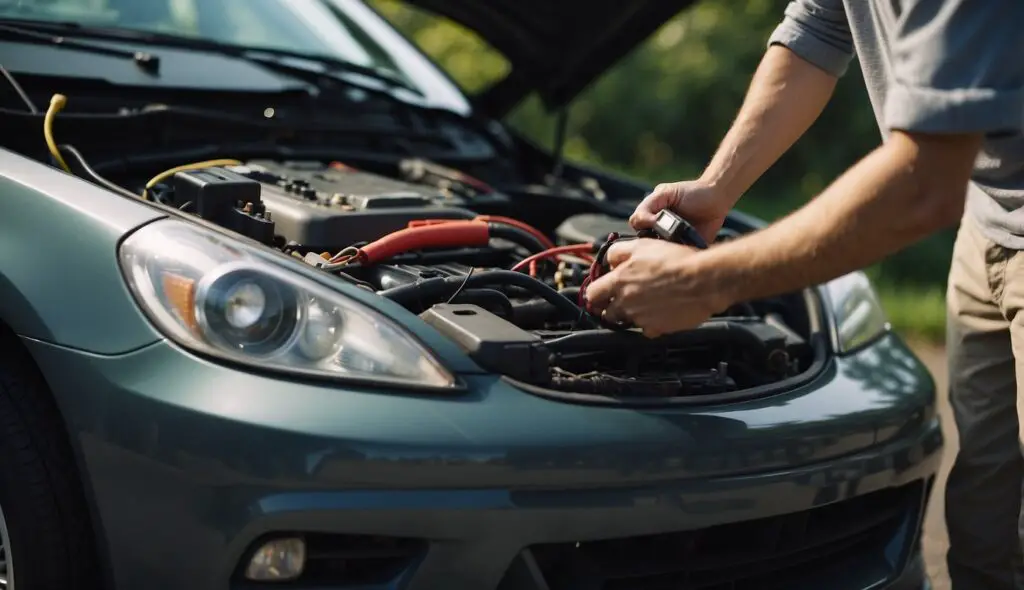A bad starter can be quite a headache for any car owner, and learning how to start a car with a faulty starter is crucial to prevent being stranded in inconvenient situations. A starter is an essential component of a vehicle’s ignition system, as it is responsible for initiating the engine’s rotation. When a starter malfunctions, it can render the car undrivable, leaving you, the driver, in a bind.
How to Start a Car with a Bad Starter
Luckily, there are some methods you can try to start your car even if you have a bad starter. This article will discuss techniques such as push-starting manual transmission vehicles, checking and cleaning battery connections, and inspecting solenoid wires. By familiarizing yourself with these methods, you’ll be better prepared to handle any situation where your car’s starter fails to function properly.
Identifying Starter Issues

Recognizing Symptoms of a Bad Starter
When dealing with starter problems, it’s crucial to recognize the symptoms of a bad starter. One of the most common symptoms is a grinding noise when trying to start the car. This noise can be indicative of worn-out gears or the starter motor not properly engaging with the flywheel.
Another common symptom is a clicking sound when turning the key. This can be due to a weak battery, but if the battery is in good condition, it typically points to a faulty starter solenoid or a poor electrical connection.
Troubleshooting the Electrical System
Before jumping to conclusions, it’s important to troubleshoot the car’s electrical system to ensure the problem lies with the starter.
- Battery: Begin by examining the battery and checking its voltage. A properly functioning battery should have a voltage of around 12.6 volts when the car is off. Ensure that the battery is not the issue by performing a load test or having it checked at an auto parts store.
- Corrosion: Carefully look for corrosion on the battery terminals and starter motor connections. Corroded battery terminals can hinder the flow of electricity, ultimately affecting the starter. You can clean the corrosion using a wire brush or a special cleaner.
- Connections: Inspect the battery cables and verify that there are no loose connections or damaged wires. Tighten any loose connections and replace any damaged cables.
- Engine Grounds: Ensure all engine grounds are secure and clean. Weak or corroded grounds can lead to a myriad of electrical problems, including starter issues.
- Starter Motor: If the above checks are all clear, closely examine the starter motor for any signs of damage, burnt terminals, or worn brushes. These issues may require replacement or repair.
- Starter Solenoid: Finally, take a look at the solenoid wire that engages the starter motor. This wire sends the message to the starter that it’s time to crank the engine. Ensure that the connection is clean and secure.
By carefully checking these components and proactively addressing any issues, you can confidently pinpoint whether the starter is indeed the cause of your car’s problem.
Starting the Car with a Bad Starter

When faced with a bad starter, maneuvering around the issue may seem daunting. However, there are several methods you can try to start your car. In this section, we explore some techniques to get you back on the road.
Manual Transmission Push-Start Technique
If your car has a manual transmission, a push-start method can come in handy. To perform this, follow these steps:
- Turn the ignition to the “On” position.
- Fully depress the clutch pedal.
- Place the gear shifter in the second gear.
- Ask a friend to push the car to gain momentum (approximately 5-10 mph).
- Release the clutch quickly while maintaining pressure on the throttle.
When done correctly, the car’s engine should start, allowing you to drive. Keep in mind this is a temporary solution, and you should address the underlying issue as soon as possible.
Tapping the Starter Method
Another temporary method to start a car with a bad starter is by tapping it gently with a hammer. A faulty starter may develop dead spots, where it remains unresponsive. Tapping the starter can help reestablish contact and get the starter working.
To do this:
- Locate the starter in your car’s engine compartment.
- Gently tap the starter with a hammer, being careful not to damage it.
After tapping the starter, try starting your car. If this method works, remember that it’s a temporary fix, and you need to have the starter examined by a professional.
Bypassing the Starter Relay
You can also try bypassing the starter relay to start a car with a faulty starter. This method is also a temporary fix, but it might help you get to your destination.
To bypass the starter relay, follow these steps:
- Locate the starting system’s relay – you might need to consult your car’s manual.
- Identify the specific terminals that connect to the starter solenoid.
- Connect a jumper wire between these terminals to bypass the relay and trigger the starter solenoid.
Make sure to remove the jumper wire once the engine starts, and drive cautiously, as certain functions, like the neutral safety switch, won’t work correctly during this bypass.
These methods aim to help you in starting a car with a bad starter. Always remember that they are temporary fixes, and you should seek professional help to address the faulty starter in the long run.
Frequently Asked Questions

What are the signs that indicate a starter is failing?
– Difficulty starting the engine, or the engine not starting at all
– A grinding or clicking noise when attempting to start the engine
– The starter staying on after the engine has started
– A slow cranking engine
– Intermittent issues with starting the vehicle
Is it possible to push start a car if the starter is malfunctioning?
Yes, it is possible to push start a car with a bad starter, but only if the vehicle has a manual transmission. In this case, one can enlist a friend to help push the car, set the vehicle in the first or second gear, and then engage the clutch to turn on the engine.
How can one jumpstart a vehicle when facing starter issues?
Jumpstarting a car with a bad starter can be done by using a set of jumper cables and another vehicle with a charged battery. Connect the positive and negative terminals from the donor vehicle’s battery to the same terminals on the car with the bad starter. The increased power from the donor vehicle may be sufficient to start the car with the faulty starter.
Will a vehicle continue to run after being started with a defective starter?
Once a vehicle with a defective starter has been started, it will generally continue to run. However, there’s a risk of the starter failing completely, leaving the vehicle unable to start again. It’s essential to address the issue as soon as possible to prevent further damage and inconvenient breakdowns.
Are there temporary fixes to start a car with a problematic starter?
There are some temporary fixes that could potentially start a car with a bad starter. These include:
- Tapping on the starter with a tool, like a hammer, to help free up a stuck gear or solenoid
- Clean the starter terminal with a wire brush if there’s corrosion that might interrupt electrical flow
- Inspecting and tightening any loose connections on the starter and solenoid
These methods, however, might not work in all cases and should be treated as temporary solutions. It is best to seek professional help to properly diagnose and repair the starter issue.
What should be done to confirm if the starter is indeed faulty?
To confirm if the starter is faulty, it is recommended to:
- Check the battery and its connections
- Test the starter motor for any issues
- Inspect the starter relay and solenoid
- Examine the ignition switch for wear or damage
If these tests indicate that the starter is the issue, it should be replaced by a professional mechanic.






